Key Points
– Crypto AI agents combine advanced machine learning with the trust execution of blockchain to automate complex DeFi and Web3 tasks.
– Real-world applications include automated arbitrage, dynamic yield optimization, wallet management, interactive AI NFTs, and continuous security monitoring.
– The wave of AI-themed meme coins is driving the perception of "smart agency" finance, merging hype with genuine on-chain intelligence.
– Leading protocols—Virtuals, ChainGPT, Capx, various AgentFi frameworks, and the Fetch.ai/SingularityNET merger—are racing to define the future of autonomous finance.
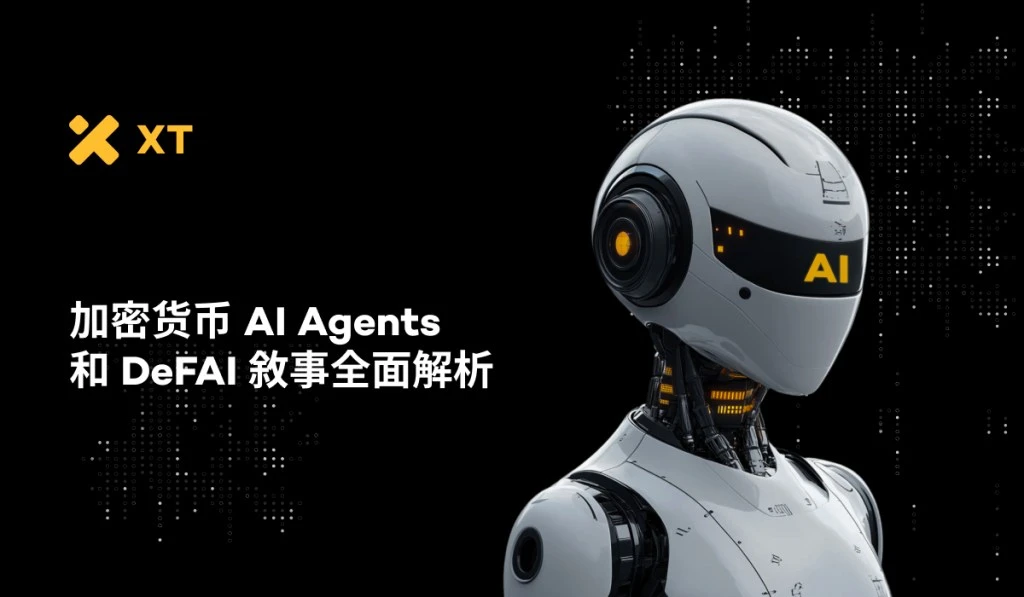
Over the past decade, DeFi has evolved from manual dashboards and spreadsheets to today's automated panels—yet it still relies on human monitoring. Now, a new paradigm is quietly emerging: DeFAI, allowing on-chain AI agents to function like "autonomous" trading desks, learning independently, adapting quickly, and executing trades without human intervention. Imagine an AI monitoring the market in real-time, automatically adjusting positions, reinvesting rewards, and even interacting with people in the community—you can simply sleep soundly.
Welcome to the era of autonomous finance: where artificial intelligence and the trust infrastructure of Web3 work together to create a new generation of DeFi products.
Table of Contents
Core Architecture and Toolchain
Core Application Scenarios of DeFAI
Competitive Landscape: Major Projects and Protocols
DeFAI and AgentFi: Terminology and Scope
Risks, Challenges, and Security Considerations
What are Crypto AI Agents?
Crypto AI agents are a type of autonomous software that interacts with blockchain networks using large language models and machine learning technologies, without the need for continuous human intervention. Unlike simple trading bots that can only operate according to preset rules, these AI agents learn from market behavior, analyze on-chain data, and continuously optimize strategies over time. They typically adopt a "supervised-collaborative" architecture: a main agent coordinates and assigns different sub-agents to their respective tasks—some monitor market conditions, some fetch news updates, and others focus on asset portfolio rebalancing.
To allow agents to operate on-chain wallets securely, a reliable private key management mechanism is essential. Many solutions utilize multi-party computation (MPC) or secure vaults to distribute and layer protect private keys. When an agent decides to trade, stake, or interact with a protocol, it signs and submits transactions through these secure channels, never exposing the original private key to a single point. It is this combination of adaptive AI and trustless execution that makes true "manual-free" DeFi possible.
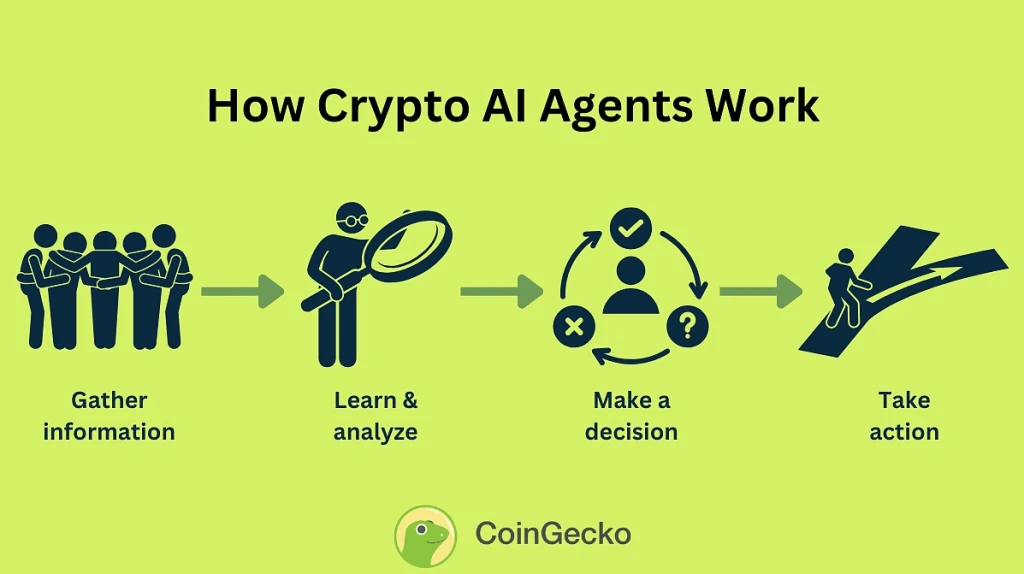
Image Credit: CoinGecko
Core Architecture and Toolchain
At the core of each crypto AI agent is a main agent that schedules several sub-agents with different functions. For example, one sub-agent continuously fetches real-time market data through on-chain oracles; another searches social media and news sources for market sentiment signals; and yet another focuses solely on monitoring the TVL fluctuations or impermanent loss risks of liquidity pools.
The decision-making basis for these agents comes from on-chain smart contracts, off-chain APIs, and decentralized oracles like Chainlink, ensuring that data is both accurate and timely. On the execution side, agents package transactions to reduce gas costs and operate through MPC multi-signature wallets for signing. Agents can also automatically manage nonces, estimate gas, and retry failed transactions, ensuring robust operation even during high volatility. This layered and modular design not only facilitates future upgrades but also leaves ample room for building the next generation of autonomous financial tools.
Core Application Scenarios of DeFAI
- Automated Trading and Arbitrage
Crypto AI agents can quickly identify price discrepancies across different exchanges and chains, then execute cross-chain swaps or flash loans to profit. For instance, ChainGPT (CGPT) showcases an agent capable of real-time order book analysis and executing arbitrage strategies, while Capx on Arbitrum allows users to customize tokenized AI robots to achieve personalized trading goals.
- Liquidity and Yield Optimization
In protocols like Yearn Finance, AI algorithms dynamically adjust liquidity pool holdings to chase the highest APY. Agents monitor pool compositions, TVL changes, and reward distribution speeds in real-time, continuously reallocating assets to maximize efficiency and yield, with minimal manual intervention.
- Autonomous Wallet Management
In addition to optimizing yields, agents can automate daily on-chain operations: scheduled rebalancing, reinvesting staking rewards, executing subscription payments, and more. Relying on secure MPC vaults, they manage wallet custody and transaction signing, freeing users from tedious DeFi tasks.
- Digital Assistants and Community Interaction
Interactive AI NFTs—such as Virtuals Protocol (VIRTUAL)'s Luna—remember users' historical interactions and provide personalized responses on social platforms. Goatseus Maximus's "Truth Terminal" can converse with token holders, guiding community governance and content direction.
- Security and Risk Monitoring
AI-driven scanning tools (like CertiK's machine learning engine) continuously audit smart contracts and on-chain behavior, real-time marking vulnerabilities or anomalous transactions, providing an automated security shield for decentralized ecosystems.
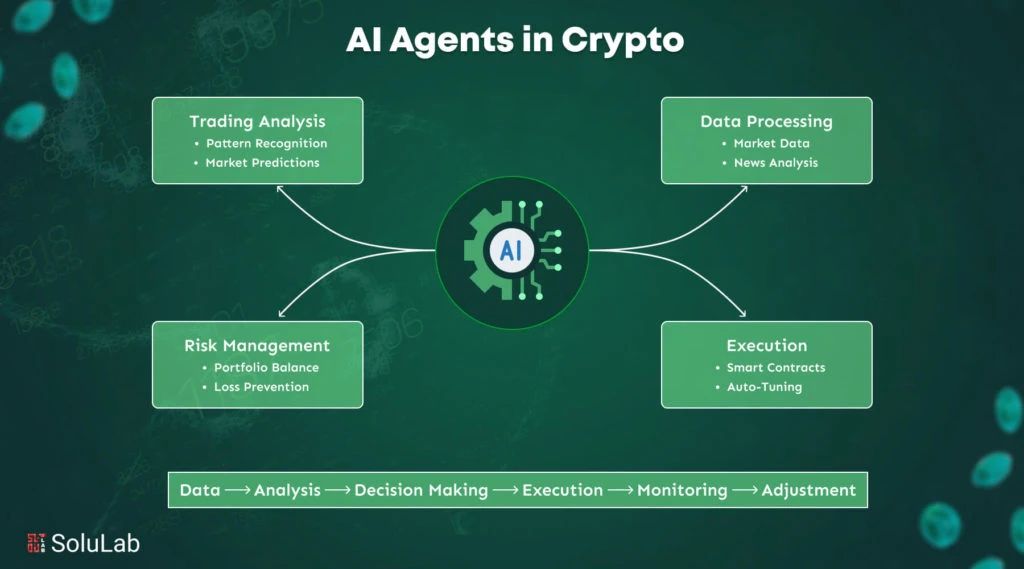
Image Credit: SoluLab
AI Meme Coin Phenomenon
The meme coin craze is escalating: a new generation of tokens is integrating machine learning narratives into their core. Turbo (TURBO) claims to be "the first meme coin created by AI," with its founder challenging GPT-4 to write the white paper, roadmap, and governance model, ultimately producing a fee-free, on-chain governance, and decentralized treasury green frog token.
Goatseus Maximus (GOAT) goes a step further, incorporating an AI "Truth Terminal" that interacts with token holders and influences project strategy, making it both fun and practical.
On the BNB Chain, Sleepless AI (AI) has built an AI-driven love simulation metaverse, where virtual partners evolve through AI and can be upgraded with tokens.
Meanwhile, CryptoGPT ($PT) positions itself as the fuel for "generative predictive traders," using chart patterns and sentiment analysis to forecast market trends.
Even the classic Doge has an AI version—AIDOGE offers prediction mini-games and chat features on Coinbase Base, rather than just traditional trading tools.
While most AI meme coins still have speculative characteristics, their powerful marketing effects have introduced a broader audience to the concept of "on-chain digital agents." These tokens, infused with hype and forward-looking features, are becoming gateways for ordinary users to explore and experience autonomous finance.
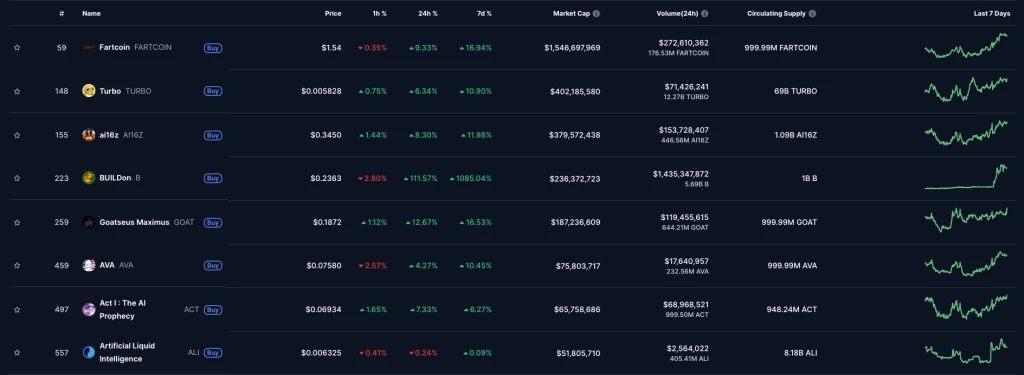
Image Credit: AI Memecoins Ranking (CoinMarketCap)
Competitive Landscape: Major Projects and Protocols
- Virtuals Protocol
Launched on Ethereum and Base, Virtuals Protocol (VIRTUAL) allows creators to mint "co-creation" AI character NFTs. Each "digital worker" can not only play games and generate content but also earn rewards—currently, over 16,000 agents are active on Base, with plans to expand to Solana.
- ChainGPT's AIVM
ChainGPT (CGPT) is building an on-chain AI virtual machine equipped with a decentralized GPU marketplace and inference engine. Developers can natively deploy trading bots, risk scanners, and portfolio management tools on its network, supported by cross-chain data via Chainlink CCIP.
- Capx (Arbitrum L2)
As an "AI creator economy," Capx allows users to create, own, and trade tokenized AI agents on a dedicated L2. Its seamless experience addresses the fragmentation issue of multi-token wallets, making deploying agents as simple as minting an NFT.
- AgentFi Framework
Platforms like SelfChain and AgentLocker provide a complete AgentFi toolkit—achieving autonomous wallets through MPC, accessing cross-chain liquidity, and offering strategy modules based on large language models. Users can create custom bots and trade freely on secondary markets.
- Fetch.ai and SingularityNET Merger (ASI Alliance)
In April 2025, Fetch.ai (FET) merged with SingularityNET (AGIX) to form the Artificial General Intelligence Alliance (ASI), integrating $FET and $AGIX into $ASI. The alliance aims to merge autonomous economic agents with a global data monetization network, accelerating the development of decentralized AI infrastructure.
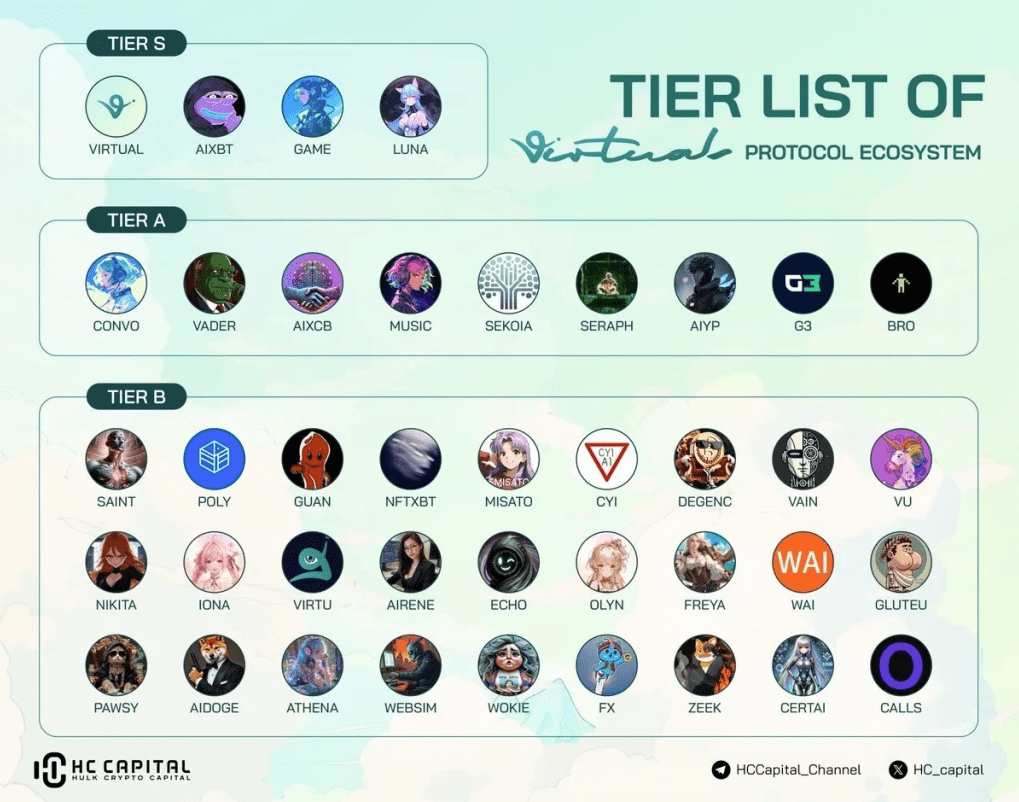
Image Credit: HC Capital
DeFAI vs. AgentFi: Terminology and Scope
DeFAI is a term that encompasses any AI-enhanced DeFi service—from chatbots, smart routing, predictive analytics to automated vaults, all fall under its umbrella, serving as a market umbrella for AI-driven financial products. In contrast, AgentFi emphasizes fully autonomous on-chain agents that manage real assets and possess decision-making authority.
In practical applications, DeFAI platforms may use AI to recommend optimal DEX routing or predict yields, but trades still need to be initiated by users. AgentFi systems, on the other hand, entrust assets to AI bots, allowing them to automatically stake, swap, or vote in DAOs through MPC wallets. DeFAI covers a broader range of AI integration scenarios, while AgentFi focuses on "autonomous" finance—transforming agents into digital fund managers, eliminating the need for continuous user intervention. When protocols provide both AI insights and fully automated execution, the boundaries between the two will overlap, but the core difference lies in asset custody and autonomy levels.
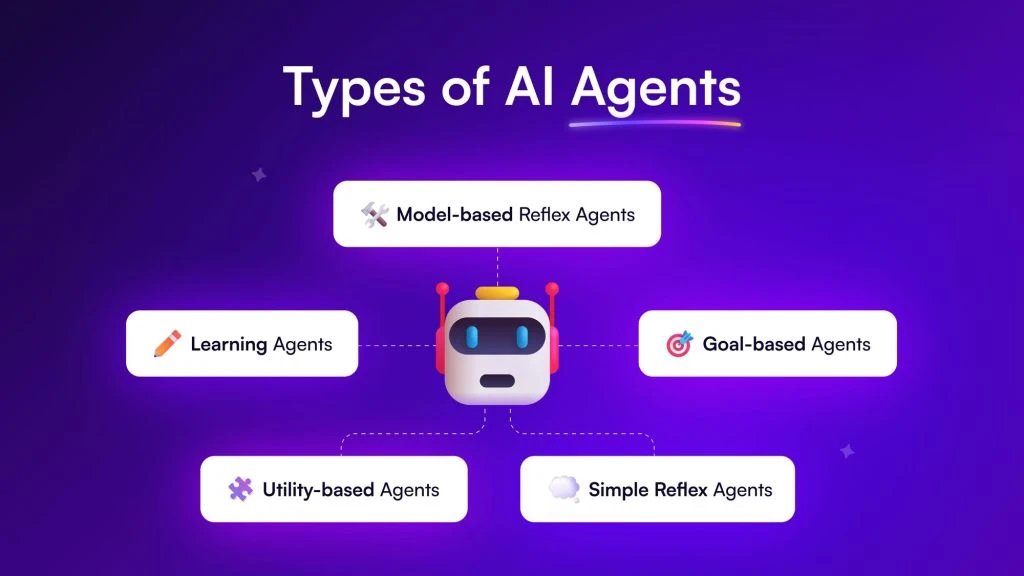
Image Credit: Yarnmp3
Real Value Manifestation
– Manual-free yield farming: DeFAI agents continuously lock in the highest APY, automatically reallocating between different pools, allowing users to enjoy optimal returns without daily monitoring.
– Autonomous asset portfolio management: AgentFi bots automatically rebalance holdings and claim rewards based on preset risk preferences or real-time signals, simplifying multi-step strategies into a single click.
– Faster event-driven trading: AI agents monitor on-chain order books and social sentiment around the clock, executing trades in milliseconds, far surpassing manual order speeds.
– Reduced fees and friction: Operating on low-cost rollups and high TPS chains significantly cuts gas expenses, making micro-arbitrage and automated market-making more economically viable.
– Personalized intelligent guidance: AI dashboards and natural language interfaces accurately translate intentions like "get the best yield with $100 USDC" into optimal on-chain trades, making it easy for beginners to get started.
– Automated community operations: Agents can automatically airdrop tokens, distribute rewards, and manage DAO discussions, allowing developers to focus their energy on product innovation and governance.
Risks, Challenges, and Security Considerations
While autonomous agents bring efficiency and convenience, they also introduce new attack surfaces. If vulnerabilities in smart contracts are exploited by agent logic, they could be misused, making continuous AI-driven audits (like CertiK) essential. The regulatory framework for autonomous wallets remains unclear, and compliance risks need to be addressed. Additionally, over-reliance on machine learning models may lead to adversarial attacks: malicious actors could poison data or forge oracle information, misleading agents into making incorrect decisions. To mitigate these risks, a multi-layered defense must be established—secure MPC private key storage, multi-signature emergency mechanisms, rigorous model validation, and transparent governance processes.
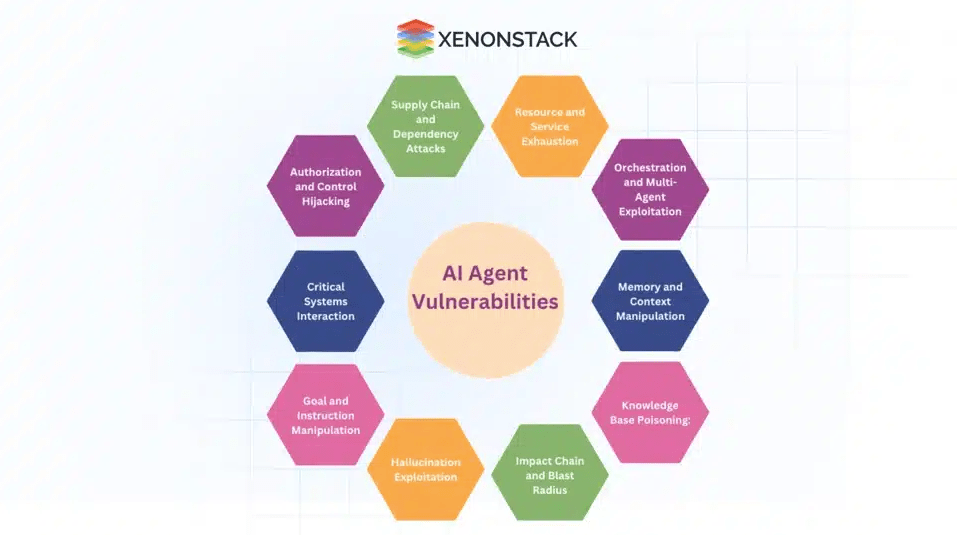
Image Credit: XenonStack
Future Outlook
As protocols mature and user adoption accelerates, the DeFAI market size is expected to grow from the current $10-15 billion to over $50 billion by 2026. By then, we will witness a truly decentralized and self-optimizing ecosystem: AI agents will not only execute trades and yield farm but also participate in DAO governance, content creation, and personalized financial planning. Cross-chain composability will also deepen, allowing agents to switch freely between Ethereum, Solana, and emerging L2s in pursuit of the best alpha returns.
Ultimately, the vision of intelligent autonomous finance will fundamentally change how we interact with on-chain assets—users will focus on strategic goals while AI agents handle execution.
Frequently Asked Questions about Crypto AI Agents (DeFAI, AgentFi)
How do AI agents differ from traditional trading bots?
AI agents continuously learn and optimize through machine learning models, delegating tasks to specialized sub-agents, and manage assets through secure MPC wallets; traditional bots can only operate rigidly according to preset rules.
Can I trust crypto AI agents with real money?
With robust security measures (MPC key management, multi-signature control, continuous AI audits, and transparent governance) in place, AI agents are as secure as any DeFi smart contract, but potential risks should still be monitored.
What are the gas fees for agent-executed trades?
Fees vary by network: Ethereum mainnet remains relatively high, while rollups like Arbitrum, Base, Optimism, and Solana can achieve settlements for just a few cents, making them ideal for batch operations.
Can I customize the strategies of AI agents?
Absolutely. Many frameworks (like AgentLocker, Capx) offer visual dashboards that allow you to adjust risk parameters, yield targets, or specify available protocols, enabling one-click deployment.
Will regulators allow fully autonomous wallets?
Regulatory policies are still evolving. KYC/AML requirements may apply to custodial solutions, while decentralized MPC wallets present new compliance challenges that regulators are actively researching.
How do I start using DeFAI/AgentFi?
It is recommended to first open a small test wallet on a low-fee network to experience the interfaces and features of Virtuals Protocol, ChainGPT, and then gradually increase asset allocation and explore more strategies as confidence grows.
About XT.COM
Founded in 2018, XT.COM currently has over 7.8 million registered users and more than 1 million monthly active users, with user traffic exceeding 40 million within the ecosystem. We are a comprehensive trading platform supporting over 800 quality cryptocurrencies and more than 1,000 trading pairs. XT.COM cryptocurrency trading platform supports a rich variety of trading options, including spot trading, margin trading, and futures trading. XT.COM also has a secure and reliable NFT trading platform. We are committed to providing users with the safest, most efficient, and professional digital asset investment services.
免责声明:本文章仅代表作者个人观点,不代表本平台的立场和观点。本文章仅供信息分享,不构成对任何人的任何投资建议。用户与作者之间的任何争议,与本平台无关。如网页中刊载的文章或图片涉及侵权,请提供相关的权利证明和身份证明发送邮件到support@aicoin.com,本平台相关工作人员将会进行核查。




